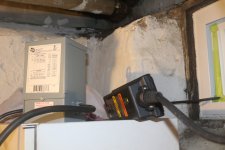Ravenvalor
Senior Member
- Location
- Triad region of NC
- Occupation
- Electrician
Hello,
Thanks for all the great help with my daily questions.
Do you think that #1 THWN is large enough to feed most electric car chargers that use 40-amp, 240-volts? The breaker will be 50-amps, the receptacle will be NEMA 14-50R, the voltage is 208-volts, the distance is 400', the conduit is 2" PVC in the ground, there won't be any other circuits in the conduit so there will be 3 - #1 THWNs and a #6 THWN ground. Once the circuit reaches its destination it will feed a spa panel with a 50-amp GFCI breaker and then the receptacle.
The Southwire Voltage drop calculator predicts 2.86% voltage drop so 2.86% from 208-volts is 199-volts. Looks rather low for a 240-volt circuit.
Thanks again.
Thanks for all the great help with my daily questions.
Do you think that #1 THWN is large enough to feed most electric car chargers that use 40-amp, 240-volts? The breaker will be 50-amps, the receptacle will be NEMA 14-50R, the voltage is 208-volts, the distance is 400', the conduit is 2" PVC in the ground, there won't be any other circuits in the conduit so there will be 3 - #1 THWNs and a #6 THWN ground. Once the circuit reaches its destination it will feed a spa panel with a 50-amp GFCI breaker and then the receptacle.
The Southwire Voltage drop calculator predicts 2.86% voltage drop so 2.86% from 208-volts is 199-volts. Looks rather low for a 240-volt circuit.
Thanks again.




